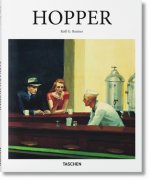
Code: 04680596
Screen in Surrealist Art and Thought
by Haim Finkelstein
An interrogation of the notion of space in Surrealist theory and philosophy, this study analyzes the manifestations of space in the paintings and writings done in the framework of the Surrealist Movement. Haim Finkelstein introduc ... more
- Language:
 English
English - Binding: Hardback
- Number of pages: 340
Publisher: Taylor & Francis Ltd, 2007
- More about this

You might also like
-

Sky in the Pie
10.56 € -18 % -

Yamaha XT & SR125 (82 - 03)
40.35 € -17 % -

Social Theory of W.E.B. Du Bois
137.46 € -

Histoire De LA Politesse De 1789 a Nos Jours
15.79 € -

Deep Leadership
27.26 € -4 % -

Hellenistic Far East
99.62 € -

Seed Fate
264.26 €
Give this book as a present today
- Order book and choose Gift Order.
- We will send you book gift voucher at once. You can give it out to anyone.
- Book will be send to donee, nothing more to care about.
More about Screen in Surrealist Art and Thought
You get 507 loyalty points
 Book synopsis
Book synopsis
An interrogation of the notion of space in Surrealist theory and philosophy, this study analyzes the manifestations of space in the paintings and writings done in the framework of the Surrealist Movement. Haim Finkelstein introduces the 'screen' as an important spatial paradigm that clarifies and extends the understanding of Surrealism as it unfolds in the 1920s, exploring the screen and layered depth as fundamental structuring principles associated with the representation of the mental space and of the internal processes that eventually came to be linked with the Surrealist concept of psychic automatism. Extending the discussion of the concepts at stake for Surrealist visual art into the context of film, literature and criticism, this study sheds new light on the way 'film thinking' permeates Surrealist thought and aesthetics. In early chapters, Finkelstein looks at the concept of the screen as emblematic of a strand of spatial apprehension that informs the work of young writers in the 1920s, such as Robert Desnos and Louis Aragon. He goes on to explore the way the spatial character of the serial films of Louis Feuillade intimated to the Surrealists a related mode of vision, associated with perception of the mystery and the Marvelous lurking behind the surfaces of quotidian reality. The dialectics informing Surrealist thought with regard to the surfaces of the real (with walls, doors and windows as controlling images), are shown to be at the basis of Andre Breton's notion of the picture as a window. Contrary to the traditional sense of this metaphor, Breton's "window" is informed by the screen paradigm, with its surface serving as a locus of a dialectics of transparency and opacity, permeability and reflectivity. The main aesthetic and conceptual issues that come up in the consideration of Breton's window metaphor lay the groundwork for an analysis of the work of Giorgio de Chirico, Rene Magritte, Max Ernst, Andre Masson, and Joan Miro. The concluding chapter considers several issues that dominate the Surrealist spatiality in the 1930s. Derived from the various spatial concepts associated with the screen paradigm, at times in contradistinction to them, these issues, as the author argues, reflect a gradual eclipse of the screen paradigm in the early years of the decade.
 Book details
Book details
Book category Books in English The arts History of art / art & design styles History of art & design styles: from c 1900 -
201.77 €
- Full title: Screen in Surrealist Art and Thought
- Author: Haim Finkelstein
- Language:
 English
English - Binding: Hardback
- Number of pages: 340
- EAN: 9780754661160
- ISBN: 0754661164
- ID: 04680596
- Publisher: Taylor & Francis Ltd
- Weight: 874 g
- Dimensions: 241 × 163 × 28 mm
- Date of publishing: 23. July 2007
Trending among others
-

Bloodborne Official Artworks
34.41 € -24 % -

Dark Souls III: Design Works
38.13 € -24 % -

Dark Souls: Design Works
33.40 € -17 % -

Hopper
15.69 € -7 % -

Dark Souls II: Design Works
37.23 € -26 % -

Bauhaus
13.78 € -9 % -

Final Fantasy Ultimania Archive Volume 1
35.11 € -13 % -

Hilma af Klint
54.23 € -16 % -

Sketchbook of Loish
27.87 € -21 % -

Behold!!! The Protong
29.38 € -27 % -

David Lynch: The Unified Field
36.82 € -8 % -

Sanja Ivekovi?: Sweet Violence
39.24 € -22 % -

Never Lasting Miracles: The Art Of Todd Schorr
56.75 € -23 % -

Dora Maar - with & without Picasso
20.92 € -4 % -

Dave Mckean: Short Films (blu-ray + Book)
19.21 € -26 % -

Cats Galore
19.61 € -24 % -

Monster Hunter Illustrations 2
41.85 € -24 % -

The Legend of Zelda: Hyrule Historia
36.92 € -9 % -

Grapefruit
20.52 € -20 % -

Dali. The Paintings
20.42 € -

Edward Hopper
11.46 € -27 % -

Art of John Harris: Beyond the Horizon
25.15 € -28 % -

Breaking the Rules of Watercolour
20.22 € -28 % -

Adolf Loos
14.08 € -7 % -

Principles of Creature Design
37.23 € -22 % -

Digital Painting with KRITA 2.9
30.78 € -23 % -

Palette Perfect
22.33 € -20 % -

The Art of Horizon Zero Dawn
32.19 € -20 % -

Pop Art
14.38 € -15 % -

Rothko
14.78 € -2 % -

Gio Ponti
15.69 € -7 % -

Frida Kahlo at Home
25.35 € -20 % -

David Hockney's Dog Days
10.25 € -23 % -

O'Keeffe
15.39 € -9 % -

de Lempicka
17 € -18 % -

Art Deco Complete
60.77 € -27 % -

Anselm Kiefer
33.80 € -25 % -

Munch
15.49 € -

Net of Being
42.66 € -15 % -

Notebooks
33.90 € -9 % -

Astrology, Magic, and Alchemy in Art
29.68 € -

Ayahuasca Visions of Pablo Amaringo
38.23 € -23 % -

Life With Picasso
15.09 € -18 % -

Beauty of Kinbaku
38.43 € -5 % -

Cy Twombly
45.18 € -7 % -

Undisputed Street Fighter: A 30th Anniversary Retrospective
35.31 € -13 % -

Hundertwasser
16.29 € -23 % -

Koenig
15.29 € -9 % -

Neo Rauch
53.43 € -3 %
Collection points Bratislava a 2642 dalších
Copyright ©2008-24 najlacnejsie-knihy.sk All rights reservedPrivacyCookies



 15549 collection points
15549 collection points Delivery 2.99 €
Delivery 2.99 € 02/210 210 99 (8-15.30h)
02/210 210 99 (8-15.30h)